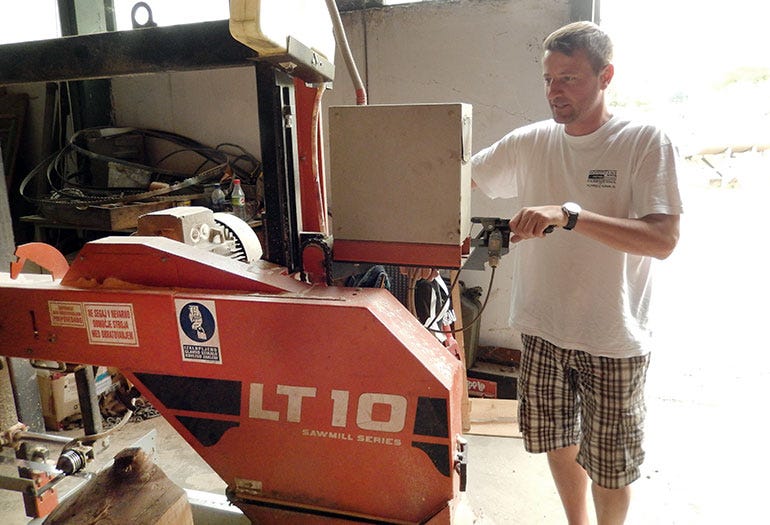Faced with post-crisis difficulties, this Slovenian sawmill company documents their successful efforts to diversify and improve profit margins by incorporating an LT10 sawmill.
Economic downturns are well known for bringing difficulty, but not much is said about the opportunities that also appear. If the business is open to change, times of economic crisis can actually benefit the business and secure its long-term future. In Prevalje, Slovenia, the principle industry for four hundred years has been iron and metals production. Small businesses such as Graplas sawmill focused on serving this industry successfully for many years.
“Before the crisis, 85% of our work was for the metal companies,” shares Sasko Taks, owner of the Graplas sawmill company. His father and uncle started the business in 1994 with an old sawmill from the 1950s, providing wood products that the metal companies require in their production.
Diversification
In 2008, orders dropped dramatically and the prospects did not look good. Sasko had only begun to manage the company three years earlier. He knew he had to do something new in order to keep the family business afloat.
“We started new business divisions,” recalls Sasko. The first new business operation they started was offering construction services. A crew of five employees build 2-3 houses annually, as well as do renovation and miscellaneous construction in the region. A recent project they built was playground equipment for the town park.
Another business operation launched was local transport services. Sasko discovered that local employees for Bosch-Siemens were regularly driving to Germany for meetings, and were using their own vehicles for transportation. Sasko purchased several minivans and made an offer to arrange all the needed transport for these employees. His offer was accepted, and it is a winning situation for all involved. Sasko installed 220V sockets and a satellite internet connection so the employees could continue to work during the long drive of 500km.
Sawmill and woodworking shop improvements
Not only did Sasko create new avenues for profit, but analysed their existing business for improvements. “Our old sawmill could not cut logs larger than 45cm diameter,” explains Sasko, “We needed more capacity.” It was around this same time that a local supplier of logging equipment, Famteh, also began supplying Wood-Mizer sawmills to Slovenia.
“Sasko Taks was our very first Wood-Mizer customer,” recalls Matjaz Kolar, a manager at Famteh. “He purchased a LT10 based on our recommendation when we first started.” The Wood-Mizer LT10 sawmill is a very basic sawmill that cuts logs into high quality lumber for a fraction of the cost of other sawmills. The sawmill comes with a 5.5kW electric motor, modular frame, and can cut logs up to 70cm in diameter. The operator sets the cutting height using a hand crank, and to cut, he simply pushes the head forward.
“Frankly, the price was so good, I bought it without hesitation,” Sasko remembers. “My only concern was if such a small, low-priced machine could cut large diameter logs well.” After a few days of cutting, his concerns were put to rest. He published a video to YouTube of his little LT10 sawmill successfully cutting a log 1m in diameter!
Sasko’s company continues to stay busy with wood orders. They produce wooden boxes for a company called Nozi Ravne, which is well known for their high quality knives for industrial cutting applications. They also cut timber for building 100x100mm wooden boxes for shipping metal. They primarily cut Slovenia spruce. Their volume does not need to be high, because the value of their final wood products is high.
“Focusing only on volume cutting is an outdated approach,” shares Matjaz Kolar from Famteh. “It is important to consider how you are making your profits, and try to make products that require less wood but result in higher added values.”
Sawmill efficiency
More economical sawmilling methods have also contributed significantly to Sasko’s growing profit margins. The 5.5kW electric sawmill motor consumes significantly less energy than their old machine, but actually cuts larger logs. Another money saving improvement is the narrow blade used to cut the wood. The blade width is only 2mm, so more of each log results in more timber and less is turned into sawdust. As a rule of thumb, the LT10 gives Sasko an additional board from every log as a direct result. Sasko uses all his wood waste to heat the boiler in his wood kiln, where his wood is dried.
“After six years of using the LT10 sawmill, we have not experienced any major technical problems with it,” shares Sasko. “Famteh manages our blade sharpening, which is convenient and fast. I am very satisfied with the equipment. It was a good idea to buy the LT10 sawmill, and it appeared on the market just in time for us.”
For more information, visit www.graplas.si

LT10 SAWMILL BOOSTS PROFITS FOR SLOVENIAN SAWMILL.jpg)

